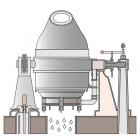During the industrial revolution, the pace of technological progress increased significantly. Before the 1850s, important inventions were created through trial and error by persistent individuals who frequently worked on their own and spent their time meticulously and continuously making improvements. In time, technological developments became based on scientific methods, and the systematic creation of new innovations became possible. The implementation of empirical methods, which resulted in more exact conclusions, allowed engineers to identify and develop precise solutions for problems in the production of commodities, thereby fueling the developments of essential innovations in the fields of pharmacy, medicine, the food industry and the production of plastics.
An example of this is the Bessemer process, the first inexpensive industrial process for the mass production of steel. Science also led to the publication of Rachel Carson’s book “Silent Spring” in the 1960s, thereby giving rise to environmental consciousness. It is hard to imagine life today without these things

Bessemer Process
Klára Zahrádková
Bessemer Process
Klára Zahrádková
Drawn by Klára Zahrádková , 2014.  This work is licensed under a Creative Commons Attribution-NonCommercial-NoDerivatives 4.0 International License.
This work is licensed under a Creative Commons Attribution-NonCommercial-NoDerivatives 4.0 International License.
Of Iron and Wind: The Bessemer process
Text and images by Klára Zahrádková
University of the Arts (UdK), Berlin

From Iron and Wind
Henry Bessemer and his steel converter
Middle of the nineteenth century: Producing steel is hard work and requires manual labor. The demand for iron is rapidly increasing through.
From Iron and Wind
Henry Bessemer and his steel converter
Middle of the nineteenth century: Producing steel is hard work and requires manual labor. The demand for iron is rapidly increasing through.
Drawn by Klára Zahrádková , 2014.  This work is licensed under a Creative Commons Attribution-NonCommercial-NoDerivatives 4.0 International License.
This work is licensed under a Creative Commons Attribution-NonCommercial-NoDerivatives 4.0 International License.
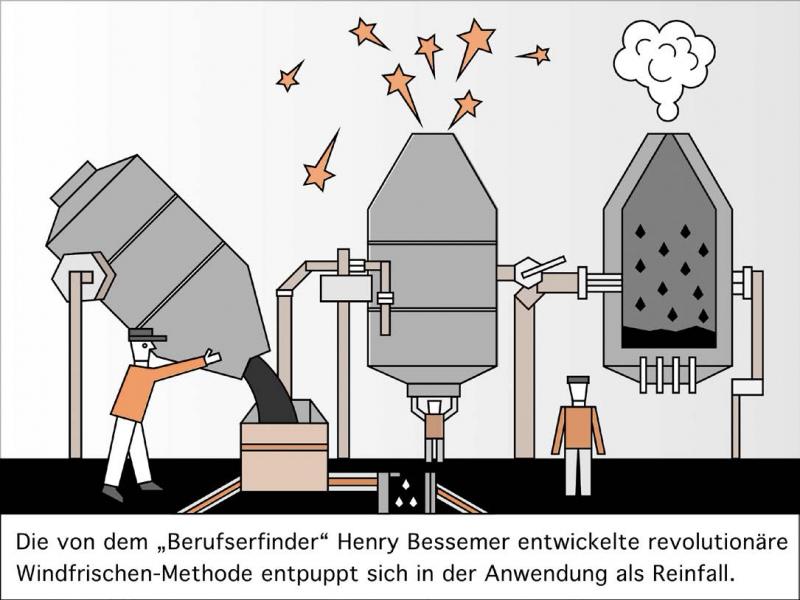
The new, revolutionary Bessemer method developed by “inventor” Henry Bessemer ends up being a complete failure in practice.
The new, revolutionary Bessemer method developed by “inventor” Henry Bessemer ends up being a complete failure in practice.
Drawn by Klára Zahrádková , 2014.  This work is licensed under a Creative Commons Attribution-NonCommercial-NoDerivatives 4.0 International License.
This work is licensed under a Creative Commons Attribution-NonCommercial-NoDerivatives 4.0 International License.
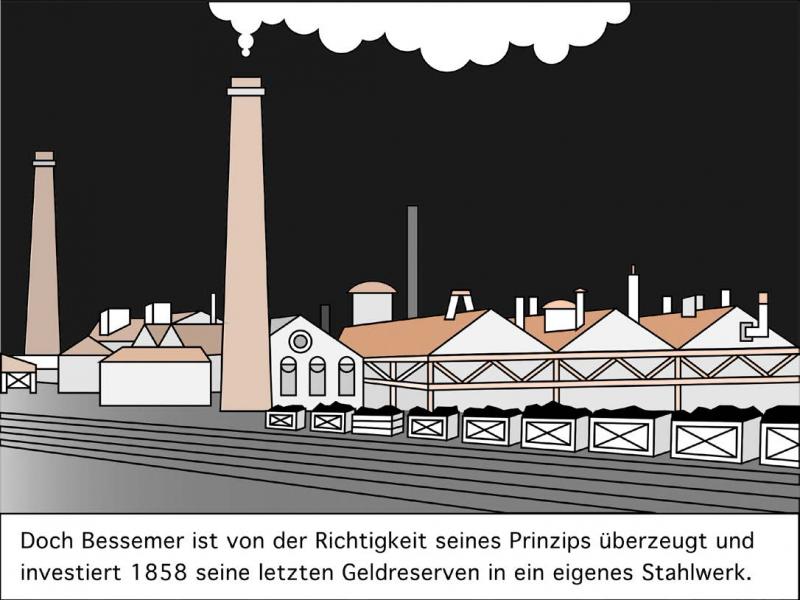
But Bessemer is convinced that his principle is correct and in 1858 invests the last of his savings in his own personal steel mill.
But Bessemer is convinced that his principle is correct and in 1858 invests the last of his savings in his own personal steel mill.
Drawn by Klára Zahrádková , 2014.  This work is licensed under a Creative Commons Attribution-NonCommercial-NoDerivatives 4.0 International License.
This work is licensed under a Creative Commons Attribution-NonCommercial-NoDerivatives 4.0 International License.
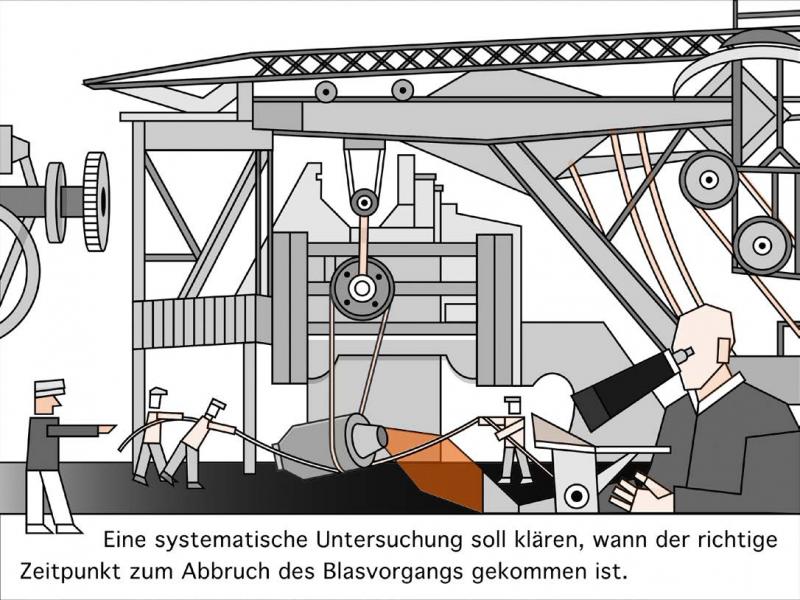
A systematical analysis should help us figure out when the right moment to interrupt the explosion process is.
A systematical analysis should help us figure out when the right moment to interrupt the explosion process is.
Drawn by Klára Zahrádková , 2014.  This work is licensed under a Creative Commons Attribution-NonCommercial-NoDerivatives 4.0 International License.
This work is licensed under a Creative Commons Attribution-NonCommercial-NoDerivatives 4.0 International License.
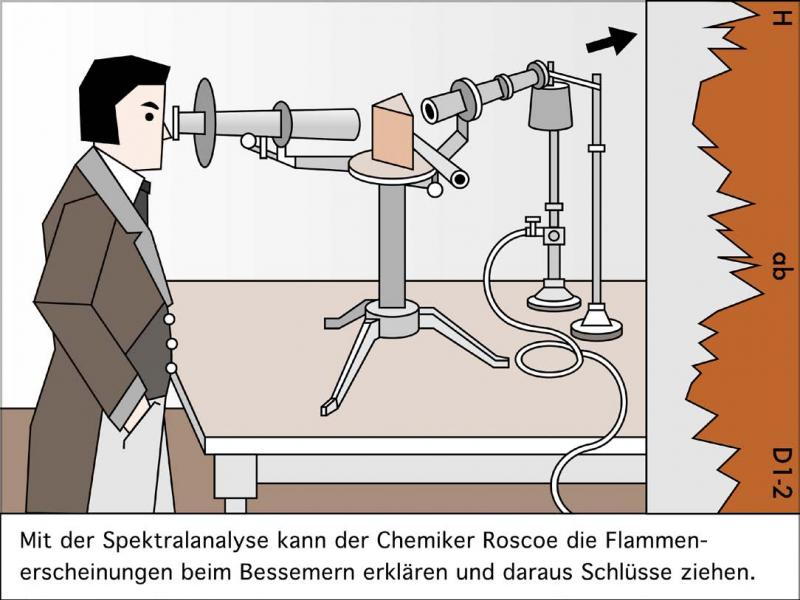
Using spectrum analysis, the chemist Roscoe can examine the flame phenomenon of the Bessemer process and from that, draw conclusions.
Using spectrum analysis, the chemist Roscoe can examine the flame phenomenon of the Bessemer process and from that, draw conclusions.
Drawn by Klára Zahrádková , 2014.  This work is licensed under a Creative Commons Attribution-NonCommercial-NoDerivatives 4.0 International License.
This work is licensed under a Creative Commons Attribution-NonCommercial-NoDerivatives 4.0 International License.
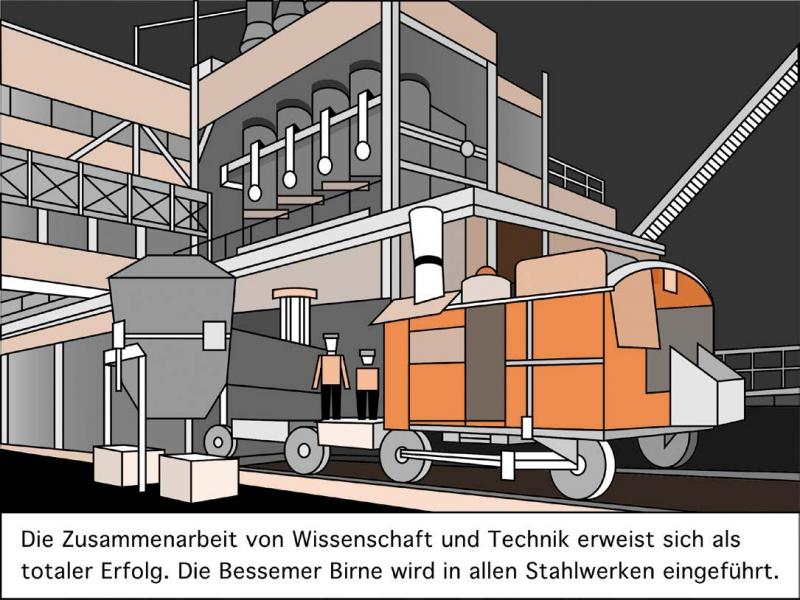
The cooperation between science and technology proves to be a great success. The Bessemer converters are introduced into all steel mills.
The cooperation between science and technology proves to be a great success. The Bessemer converters are introduced into all steel mills.
Drawn by Klára Zahrádková , 2014.  This work is licensed under a Creative Commons Attribution-NonCommercial-NoDerivatives 4.0 International License.
This work is licensed under a Creative Commons Attribution-NonCommercial-NoDerivatives 4.0 International License.
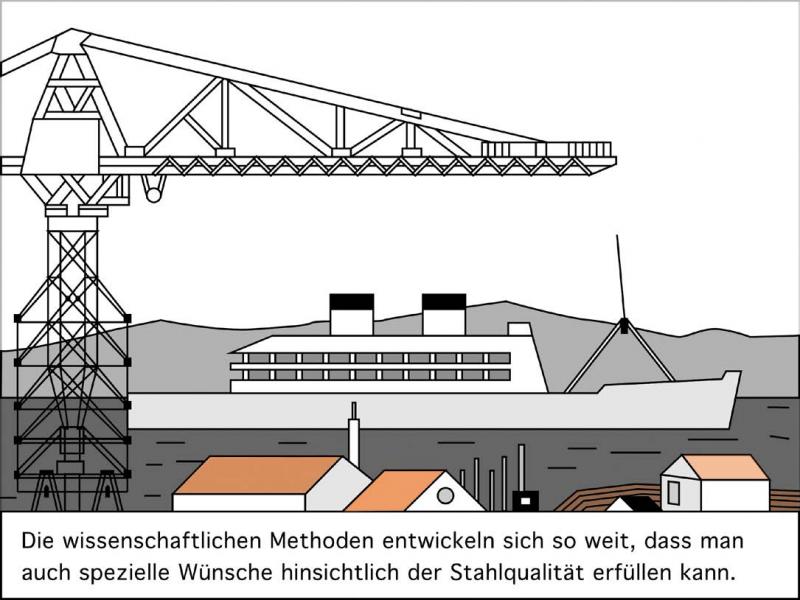
Scientific methods develop so much that special requests regarding the quality of the steel can be fulfilled.
Scientific methods develop so much that special requests regarding the quality of the steel can be fulfilled.
Drawn by Klára Zahrádková , 2014.  This work is licensed under a Creative Commons Attribution-NonCommercial-NoDerivatives 4.0 International License.
This work is licensed under a Creative Commons Attribution-NonCommercial-NoDerivatives 4.0 International License.
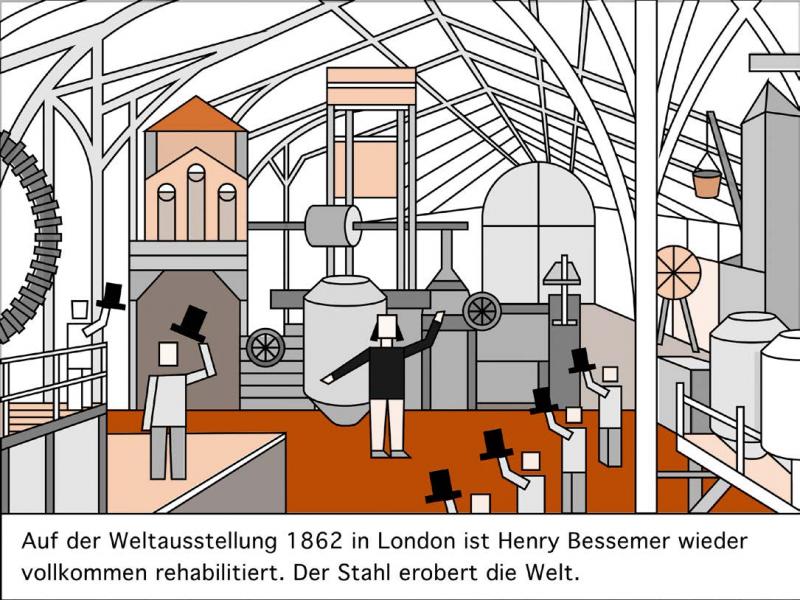
At the world fair in 1862, Henry Bessemer proves himself. Steel takes over the world.
At the world fair in 1862, Henry Bessemer proves himself. Steel takes over the world.
Drawn by Klára Zahrádková , 2014.  This work is licensed under a Creative Commons Attribution-NonCommercial-NoDerivatives 4.0 International License.
This work is licensed under a Creative Commons Attribution-NonCommercial-NoDerivatives 4.0 International License.
Artist’s comment:
The development of the Bessemer converter was long and complex and is therefore impossible to tell in just eight panels. In the beginning it was a chance discovery, then adapted through a series of coincidences and many favorable circumstances. Will and perseverance also played a major role, as well as the assistance of many people and, finally, good timing. It took so many different steps that the existence of the Bessemer converter seems quite improbable. Yet today it is a common and ubiquitous technology that plays an essential role in everyday life.
How to cite
Zahrádková, Klára. “The Bessemer Process.” Environment & Society Portal, Multimedia Library, 2014. http://www.environmentandsociety.org/node/6633/.
The comic also appears in Alexandra Hamann, Reinhold Leinfelder, Helmuth Trischler, and Henning Wagenbreth, eds., Anthropozän – 30 Meilensteine auf dem Weg in ein neues Erdzeitalter. Eine Comic-Anthologie (Munich: Deutsches Museum, 2014).
This work is licensed under a Creative Commons Attribution-NonCommercial-NoDerivatives 4.0 International License.


